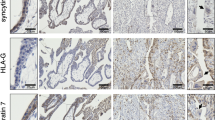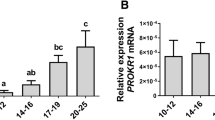Abstract
Hepatocyte growth factor activator inhibitor-1 (HAI-1) is a Kunitz-type transmembrane serine protease inhibitor that forms inhibitor complexes with several trypsin-like serine proteases and is required for mouse placental development and embryo survival. Here we show that the essential function of HAI-1 in placentation and all other embryonic processes is to restrict the activity of the type II transmembrane serine protease, matriptase. Enzymatic gene trapping of matriptase combined with HAI-1 immunohistochemistry revealed that matriptase is co-expressed with HAI-1 in both extraembryonic and embryonic tissues. As early as embryonic day 8.5, matriptase and HAI-1 were expressed in a population of chorionic trophoblasts. Ablation of HAI-1 disrupted the epithelial integrity of this cell population, causing disorganized laminin deposition and altered expression of E-cadherin and β-catenin. This led to a complete loss of undifferentiated chorionic trophoblasts after embryonic day 9.5 and prevented the formation of the placental labyrinth. Genetic ablation of matriptase activity in HAI-1-deficient embryos, however, restored the integrity of chorionic trophoblasts and enabled placental labyrinth formation and development to term. Furthermore, matriptase/HAI-1 double-deficient mice were phenotypically indistinguishable from matriptase single-deficient littermates.
This is a preview of subscription content, access via your institution
Access options
Subscribe to this journal
Receive 50 print issues and online access
$259.00 per year
only $5.18 per issue
Buy this article
- Purchase on Springer Link
- Instant access to full article PDF
Prices may be subject to local taxes which are calculated during checkout





Similar content being viewed by others
Abbreviations
- E:
-
embryonic day
- ES:
-
embryonic stem (cells)
- HAI:
-
hepatocyte growth factor activator inhibitor
- X-gal:
-
5-bromo-4-chloro-3-indolyl-beta-D-galactopyranoside
References
Ascenzi P, Bocdi A, Bolognesi M, Spallarose A, Colletta M, De Cristofaro R et al. (2003). The bovine basic pancreatic trypsin inhibitor (Kunitz inhibitor): a milestone protein. Curr Protein Pept Sci 4: 231–251.
Fan B, Wu TD, Li W, Kirchhofer D . (2005). Identification of hepatocyte growth factor activator inhibitor-1B as a potential physiological inhibitor of prostasin. J Biol Chem 280: 34513–34520.
Gailani D, Lasky NM, Broze Jr GJ . (1997). A murine model of factor XI deficiency. Blood Coagul Fibrinolysis 8: 134–144.
Gao F, Shi HY, Daughty C, Cella N, Zhang M . (2004). Maspin plays an essential role in early embryonic development. Development 131: 1479–1489.
Herter S, Piper DE, Aaron W, Gabriele T, Cutler G, Cao P et al. (2005). Hepatocyte growth factor is a preferred in vitro substrate for human hepsin, a membrane-anchored serine protease implicated in prostate and ovarian cancers. Biochem J 390: 125–136.
Hooper JD, Campagnolo L, Goodarzi G, Truong TN, Stuhlmann H, Quigley JP . (2003). Mouse matriptase-2: identification, characterization and comparative mRNA expression analysis with mouse hepsin in adult and embryonic tissues. Biochem J 373: 689–702.
Huang ZF, Higuchi D, Lasky N, Broze Jr GJ . (1997). Tissue factor pathway inhibitor gene disruption produces intrauterine lethality in mice. Blood 90: 944–951.
Ishiguro K, Kojima T, Kadomatsu K, Nakayama Y, Takagi A, Suzuki M et al. (2000). Complete antithrombin deficiency in mice results in embryonic lethality. J Clin Invest 106: 873–878.
Itoh H, Naganuma S, Takeda N, Miyata S, Uchinokura S, Fukushima T et al. (2004). Regeneration of injured intestinal mucosa is impaired in hepatocyte growth factor activator-deficient mice. Gastroenterology 127: 1423–1435.
Kaufmann MH, Bart S . (1999). The Anatomical Basis of Mouse Development, revised edn. Academic Press: San Diego, CA.
Lin CY, Anders J, Johnson M, Dickson RB . (1999). Purification and characterization of a complex containing matriptase and a Kunitz-type serine protease inhibitor from human milk. J Biol Chem 274: 18237–18242.
List K, Haudenschild CC, Szabo R, Chen W, Wahl SM, Swaim W et al. (2002). Matriptase/MT-SP1 is required for postnatal survival, epidermal barrier function, hair follicle development, and thymic homeostasis. Oncogene 21: 3765–3779.
List K, Szabo R, Molinolo A, Nielsen BS, Bugge TH . (2006). Delineation of matriptase protein expression by enzymatic gene trapping suggests diverging roles in barrier function, hair formation, and squamous cell carcinogenesis. Am J Pathol 168: 1513–1525.
List K, Szabo R, Molinolo A, Sriuranpong V, Redeye V, Murdock T et al. (2005). Deregulated matriptase causes ras-independent multistage carcinogenesis and promotes ras-mediated malignant transformation. Genes Dev 19: 1934–1950.
Oberst MD, Chen LY, Kiyomiya K, Williams CA, Lee MS, Johnson MD et al. (2005). HAI-1 regulates activation and expression of matriptase, a membrane-bound serine protease. Am J Physiol Cell Physiol 289: C462–C470.
Oberst MD, Singh B, Ozdemirli M, Dickson RB, Johnson MD, Lin CY . (2003a). Characterization of matriptase expression in normal human tissues. J Histochem Cytochem 51: 1017–1025.
Oberst MD, Williams CA, Dickson RB, Johnson MD, Lin CY . (2003b). The activation of matriptase requires its noncatalytic domains, serine protease domain, and its cognate inhibitor. J Biol Chem 278: 26773–26779.
Oh J, Takahashi R, Kondo S, Mizoguchi A, Adachi E, Sasahara RM et al. (2001). The membrane-anchored MMP inhibitor RECK is a key regulator of extracellular matrix integrity and angiogenesis. Cell 107: 789–800.
Ohmuraya M, Hirota M, Araki M, Mizushima N, Matsui M, Mizumoto T et al. (2005). Autophagic cell death of pancreatic acinar cells in serine protease inhibitor Kazal type 3-deficient mice. Gastroenterology 129: 696–705.
Riley P, Anson-Cartwright L, Cross JC . (1998). The Hand1 bHLH transcription factor is essential for placentation and cardiac morphogenesis. Nat Genet 18: 271–275.
Shimomura T, Denda K, Kitamura A, Kawaguchi T, Kito M, Kondo J et al. (1997). Hepatocyte growth factor activator inhibitor, a novel Kunitz-type serine protease inhibitor. J Biol Chem 272: 6370–6376.
Szabo R, Netzel-Arnett S, Hobson JP, Antalis TM, Bugge TH . (2005). Matriptase-3 is a novel phylogenetically preserved membrane-anchored serine protease with broad serpin reactivity. Biochem J 390: 231–242.
Tanaka H, Nagaike K, Takeda N, Itoh H, Kohama K, Fukushima T et al. (2005). Hepatocyte growth factor activator inhibitor type 1 (HAI-1) is required for branching morphogenesis in the chorioallantoic placenta. Mol Cell Biol 25: 5687–5698.
Velasco G, Cal S, Quesada V, Sanchez LM, Lopez-Otin C . (2002). Matriptase-2, a membrane-bound mosaic serine proteinase predominantly expressed in human liver and showing degrading activity against extracellular matrix proteins. J Biol Chem 30: 37637–37646.
Wu Q, Yu D, Post J, Halks-Miller M, Sadler JE, Morser J . (1998). Generation and characterization of mice deficient in hepsin, a hepatic transmembrane serine protease. J Clin Invest 101: 321–326.
Zeeuwen PL, van Vlijmen-Willems IM, Hendriks W, Merkx GF, Schalkwijk J . (2002). A null mutation in the cystatin M/E gene of ichq mice causes juvenile lethality and defects in epidermal cornification. Hum Mol Genet 11: 2867–2875.
Acknowledgements
We thank Drs Chen-Yong Lin and Robert Dickson for generously providing human matriptase antibody, and Drs Silvio Gutkind and Mary Jo Danton for critically reviewing this manuscript. This work was supported by the NIH Intramural program and by a grant from the Department of Defense (DAMD-17-02-1-0693) to Dr Thomas H Bugge.
Author information
Authors and Affiliations
Corresponding author
Additional information
Supplementary Information accompanies the paper on the Oncogene website (http://www.nature.com/onc).
Rights and permissions
About this article
Cite this article
Szabo, R., Molinolo, A., List, K. et al. Matriptase inhibition by hepatocyte growth factor activator inhibitor-1 is essential for placental development. Oncogene 26, 1546–1556 (2007). https://doi.org/10.1038/sj.onc.1209966
Received:
Revised:
Accepted:
Published:
Issue Date:
DOI: https://doi.org/10.1038/sj.onc.1209966
Keywords
This article is cited by
-
The difference in the intracellular Arg/Lys-rich and EHLVY motifs contributes to distinct subcellular distribution of HAI-1 versus HAI-2
Human Cell (2022)
-
Targeted deletion of HAI-1 increases prostasin proteolysis but decreases matriptase proteolysis in human keratinocytes
Human Cell (2021)
-
Circulating SPINT1 is a biomarker of pregnancies with poor placental function and fetal growth restriction
Nature Communications (2020)
-
The Kunitz Domain I of Hepatocyte Growth Factor Activator Inhibitor-2 Inhibits Matriptase Activity and Invasive Ability of Human Prostate Cancer Cells
Scientific Reports (2017)
-
Roles of Grainyhead-like transcription factors in cancer
Oncogene (2017)



